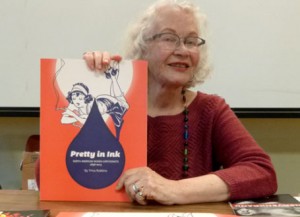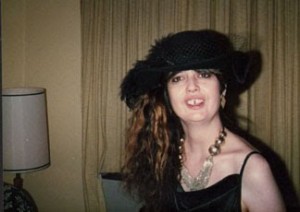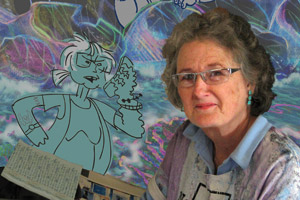Happy Women’s History Month! All through March, we’ll be celebrating women who changed free expression in comics. This week we spotlight creators who made their mark in Underground Comix.
Follow our Tumblr every weekday for biographical snippets on female creators who have changed the face of free expression in comics by pushing the boundaries of the medium and/or seen their work challenged or banned. We’re also collecting the posts here on a weekly basis.
Shary Flenniken
 Shary Flenniken grew up in a deeply conservative military household, but came of age at Vietnam protests where she found an artistic calling that would place her at the epicenter of two of the most subversive humor institutions in comics history.
Shary Flenniken grew up in a deeply conservative military household, but came of age at Vietnam protests where she found an artistic calling that would place her at the epicenter of two of the most subversive humor institutions in comics history.
Born in 1950 at the height of the baby boom, Flenniken’s early life followed her father’s career as a Rear Admiral in the United States Navy to Alaska, Panama, and Seattle. She pursued formal art education at a commercial art school in Seattle, training to produce advertisements and other commercial graphics. At an anti-war demonstration, Flenniken was drafted to produce artwork for an underground newspaper that included “cartoons advocating freedom of choice and hitchhiking.” In 1970 she met cartoonists Ted Richards, Dan O’Neill, and future husband Bobby London at the Sky River Rock Festival outside of Portland, Oregon, where she was producing the festival’s mimeographed newsletter. During the festival, they produced the four-page comic Sky River Funnies.
In 1971, Flenniken moved to San Francisco where she lived in a warehouse with Richards, London, O’Neill, and Gary Hallgren. The group would be immortalized as the Air Pirates, the notorious San Francisco underground comix collective whose antics led to a protracted legal battle with Disney that changed the face of parody law in the United States. Flenniken didn’t contribute to Air Pirates Funnies, the comic book that led to the confrontation with Disney, instead developing her own strip Trots and Bonnie.
The biography on Flenniken’s website recalls:
The real attraction of the Air Pirates odyssey was the salon atmosphere in the series of warehouses occupied by the group. The cartoonists taught and learned from each other almost constantly. There was little food or sleep. They discussed politics and pen points with equal seriousness. They traveled in a protective pack when they went out to forage for meals or a place to take a shower. O’Neill introduced Improvisational Theater exercises that he adapted for writing comic pages. These were emotional, mind-bending tests of the artist’s ability to relinquish their ego in order to participate in a team project. Not all passed.
The lessons were not always easy to swallow. One primary edict holds true today… “Develop a character and build your comic strip around its characters.” Shary’s long-running Trots and Bonnie comic strip was a result of that directive, born from memories of growing up in the saccharine Seattle suburb called Magnolia with her dog, Bonnie.
Trots and Bonnie found a home in National Lampoon, where it would appear from 1972 until 1990. Emulating the style of golden age strip cartoonists including Clare Briggs and H.T. Webster, Trots and Bonnie simultaneously skewered and explored sexuality, politics, and the counter-culture. The juxtaposition of a charming line style that evoked the innocence of an earlier era with frank, often explicit subject matter reflecting the sexually liberal culture of the 1970s allowed Flenniken to address taboo subjects with a great deal of empathy. Flenniken went on to become an editor of Lampoon from 1979 – 1981 under P.J. O’Rourke, where she covered the 1980 Democratic and Republican national conventions and recruited a variety of artists to the magazine including Mimi Pond and Rick Geary. She also co-wrote the screenplay for National Lampoon Goes To The Movies.
Flenniken’s professional practice placed her in competitive, male-dominated counter-culture institutions where she developed a uniquely impactful voice and visual style, while paving the way for others to follow. She successfully made the transition from underground comix to the mainstream distribution of Lampoon and through her work pushed back at much of the institutional sexism that pervaded both milieus. Speaking to Robert Boyd at The Comics Journal she said:
Mostly I want to be understood, for them to get what I’m saying. But I’ll settle for any reaction. It was a big deal for me to draw naked men with their penises showing in Lampoon. I wanted to put [Michelangelo’s] David on the cover, with girls making fun of his little weenie. I wanted an equal time thing because what men don’t seem to realize is that we all have the same reaction to seeing someone of our sex naked. It makes us nervous. We compare our bodies to the ones in the picture. It’s made women totally nuts.
Flenniken currently lives in Seattle, Washington where she provides freelance illustration for outlets including Mad, Details, and Graphic Classics.
—Executive Director Charles Brownstein
Trina Robbins
 Trina Robbins is without a doubt one of the most influential and prolific women creators of the comics (or comix) industry. Coming to San Francisco in the 1970s, she fell quickly under the spell of the city’s youth counterculture and free atmosphere, which fueled her desire to create what would become some of the most iconic comics about women in history.
Trina Robbins is without a doubt one of the most influential and prolific women creators of the comics (or comix) industry. Coming to San Francisco in the 1970s, she fell quickly under the spell of the city’s youth counterculture and free atmosphere, which fueled her desire to create what would become some of the most iconic comics about women in history.
In a time when the only way to truly and freely express oneself in comics came from working in channels outside of the regulatory confines of the Comics Code, Robbins dominated those arenas and quickly became a star of the underground comix movement. With a career spanning over three decades and still going, she is one of the founding members of the longest running all-women comics anthology, Wimmen’s Comix, produced the first-ever all-women comic It Ain’t Me, Babe, and contributed to numerous other iconic underground comix. Robbins has worked with everyone from Robert Crumb in the underground, to Vampirella at Warren Publishing in the late 1960s, to DC’s Wonder Woman in the 1980s. Robbins’ name is synonymous with female strength and empowerment, and it is her unique voice and approach to freedom of speech and expression that has inspired entire generations of women creators.
More than a fantastic creative voice, though, Trina Robbins has also become one of the industry’s strongest activists, advocates, and archivists of the complex role that women creators have played in comics since their inception. She has edited comics about AIDS, being pro-choice, and countless other issues, using the medium to spread awareness and educate society.
Out of her work as an advocate for contemporary issues has sprung one of her most ambitious and amazing roles as an icon in comics. Robbins has not only written comics, but contributed to numerous anthologies and historical books about comics and specifically the role that women have played in the industry. Robbins describes herself as not only a writer, but a “herstorian.” From The Brinkley Girls, to From Girls to Grrlz, to the biography of Lily Renee, Lily Renee, Escape Artist, Robbins has opened the door for a new generation of comics fans and readers to enjoy and celebrate the fantastically rich history that women have in this industry by collecting materials and presenting viewpoints that have never been seen before.
Her work as a comics creator, an educator, and an advocate is a true inspiration. Coming out of a period in American comics history restricted by mandated regulation and explicit censorship brought about by the Code, Trina Robbins has always stood up for free speech and expression by producing the works that she wanted to produce. She dominated the underground, brought a new flavor to the mainstream, and is now giving the comics industry a whole new perspective on its history.
—Contributing Editor Caitlin McCabe
Dori Seda
 The comics of Dori Seda portray her determination to do the patient work of chronicling a fun life lived against the grain.
The comics of Dori Seda portray her determination to do the patient work of chronicling a fun life lived against the grain.
Born in 1951 and encouraged from an early age to follow her father’s example as an artist, Seda pursued formal art education at Illinois State University where she achieved a B.A. in art for painting and ceramics. Her ceramic works reveal the wry and ribald wit that would characterize her later comics, especially Vibrator with 3 Attachments, which the composer Bob Davis describes as:
“Loaf-like, pink and almost two feet long, the vibrator itself was made from slabs of clay … It lay on its back with a silver post thrust into the air waiting for attachments. Dori made three. She would gleefully show them to people in the following order: first a silver, lustrous disc, such as you’d use to relieve an ache in your shoulder. Next there was a pink penis with flocked lace trim. That usually opened a few eyes. But my favorite was number three, a grey, curly poodle’s head with a glazed grin and a big, wet, pink tongue hanging out. The most captivating element of this piece was not the attachments, however. Protruding from the vibrator with grins as satisfied as the dog’s, were the heads of six cats. I always imagined that their presence had something to do with the way cats purr and vibrators hum…”
After college, Seda moved to San Francisco where she became a fixture in the Mission District art and bar scenes. With Davis as her partner-in-crime, Seda hung out at drag events, made elaborate costumes, sold hand-crafts including “mock-Arabian Nights” slippers, did illustration work, and exhibited acrylic paintings. In 1979 she went to work at Last Gasp, the venerable underground publisher and distributor, starting as a janitor and moving up to bookkeeper. Seda kept night hours, in part due to her own nocturnal rhythms, and in part to mitigate the jealously she felt when interacting with the cartoonists that came through and thought of her solely as “the bookkeeper.” Seda’s fortunes changed when R. Crumb accepted her 1977 story “Bloods in Space” for Weirdo #2. Crumb encouraged Seda, providing her with a regular berth in the anthology from 1982 until 1985.
Seda found her calling in comics. Her largely autobiographical work portrays the rude, sleazy, anything-goes sexuality of pre-AIDS San Francisco with equal parts bleak humor and cheerful enjoyment. Seda’s art stands in opposition to a cultural context that included the Meese Commission on Pornography, and Catherine MacKinnon and Andrea Dworkin‘s efforts in the anti-pornography movement. Her work depicts sexuality in a way that emphasizes feminine pleasure, power, and above all else, agency. These qualities, in the context of her irreverent and explicit drawings, contributed to her 1986 solo title Lonely Nights Comics being banned in the UK. Perhaps this brush with censorship is in part responsible for the political themes that emerged in her later stories. Her 1987 story “How Cops ‘Pick Up’ Girls” is a righteous protest against the sexual harassment and abuse of power she experienced at the hands of the SFPD that also manages to pull off a wicked punchline at the expense of her arresting officers. That same year also produced “Door of Deception, or The Right to Lie,” a collaboration with Carla Abbots exposing the tactics of anti-abortion pregnancy clinics, and “The Do-Nothing Decade,” a powerful meditation on political apathy.
Seda suffered from the respiratory disease silicosis, whose symptoms were made worse by her heavy smoking and hard living. She contracted a virulent strain of flu in the winter of 1988, dying of respiratory failure on February 25th at the warehouse she shared with Don Donahue. Seda’s mother inherited the literary rights to her work, and sought to suppress it on moral grounds. A 1987 letter written six days after her 36th birthday on lavender writing paper with the letterhead “Dori Seda – Cartoonist” saved that work from oblivion. The cartoonist Leslie Sternbergh recalls:
“TO WHOM IT MAY CONCERN,” the letter begins. “This is sort of a contract and sort of a will (although I don’t plan on dying soon.)” … What a thing for Dori to’ve said, even in jest, all the worse in retrospect. The text continues. … She makes one point clearly, and several times reiterates it – that Don [Donahue] should have her artwork. … This odd contract was at her insistence witnessed by her friends Krystine Kryttre and Dan O’Neill. For whatever reasons, she wanted a legal document.
At the 1990 San Diego Comic-Con, with the assistance of Last Gasp founder Ron Turner and attorney Mitch Berger, the process of filing that letter as Seda’s will was set in motion. In 1991 Donahue took ownership of Seda’s work, protecting her legacy. Last Gasp published Dori Stories, the definitive anthology of her art and life, in 1999.
—Executive Director Charles Brownstein
Lee Marrs
 Lee Marrs, who would become one of the first and most outspoken women creators of the underground comix movement, got her start working in the comics industry as a part-time assistant on the strips Little Orphan Annie and Hi & Lois. Although this was her beginning in the industry, her entrepreneurial drive ultimately led her to San Francisco in 1971 where she worked alongside other underground legends like Trina Robbins. Her passionate approach to comics and desire to create works that spoke to all kinds of women became a major inspiration for other women creators to get involved in the comics scene.
Lee Marrs, who would become one of the first and most outspoken women creators of the underground comix movement, got her start working in the comics industry as a part-time assistant on the strips Little Orphan Annie and Hi & Lois. Although this was her beginning in the industry, her entrepreneurial drive ultimately led her to San Francisco in 1971 where she worked alongside other underground legends like Trina Robbins. Her passionate approach to comics and desire to create works that spoke to all kinds of women became a major inspiration for other women creators to get involved in the comics scene.
In a time when mainstream comics were still being heavily regulated and censored by the Code, the fledgling underground scene was really the only place where creators could express themselves freely and produce the books that they wanted. Although it was still heavily perceived as the proverbial “boy-club,” this didn’t stop Marrs. Instead of trying to be exclusively included in their comix, Marrs made her own. The Further Fattening Adventures of Pudge, Girl Blimp was born and would run from 1973 to 1978—an incredible run for an independently created work.
Not a creator to be held back for any reason, Marrs would also contribute to other underground anthologies like Gay Comix, Star*Reach, and Heavy Metal. Her insistent drive would later lead her to becoming one of the founding members of the longest running all-women comix anthologies, Wimmen’s Comix.
Her unique voice geared towards women’s empowerment, strength, and free speech is what not only made Marrs a shining beacon in the underground, but also a power figure later in the mainstream, and ultimately an Emmy Award-winning art director of her own company, Lee Marrs Artwork. She worked for men like Joe Orlando and Tex Blaisdell, and did work on some of the most popular mainstream books including House of Secrets, Wonder Woman, and Zatanna, but first and foremost she was her own creator and business woman.
–Contributing Editor Caitlin McCabe
Roberta Gregory
Roberta Gregory grew up surrounded by comic books, and started drawing her own comics at a very young age. The 1970s found her both entering college in her native Southern California and encountering the feminist movement. As she used art and a sense of humor to explore the movement, Gregory soon found a home for her work in the influential all-women underground anthology Wimmen’s Comix and her own Dynamite Damsels series. In her own words, Gregory “was happy to be living proof that feminists did have a sense of humor, but I was really just writing and drawing the sorts of stories that I would love to read, if someone else was doing them.” Because no one was making the stories Gregory wanted to read, she felt obligated to make them herself.
Gregory continued to publish in Wimmen’s Comix into the 1980s, and her stories also appeared in nearly every issue of the Gay Comix anthology. During this period, she also started work on Winging It, an ambitious and intricate graphic novel that used dark humor to explore the relationship between a suicidal woman and a fallen angel, and Sheila and the Unicorn, a comic strip about the unrequited love between a unicorn and a human being. Toward the end of the decade, Gregory relocated to Seattle and began working with Fantagraphics Books.
In 1991, Gregory’s launched Naughty Bits and with it the character for which she is best known: Bitchy Bitch. Many related to the character, a short-tempered profanity-spewing middle-aged everywoman who doesn’t hold back when it comes to voicing her frustrations with modern life. Bitchy appeared in 40 issues of Naughty Bits, which drew to a close in 2004, but Gregory has more adventures planned for the character.
Gregory uses frequently dark humor to explore the modern world from a feminist perspective, and her groundbreaking work garners a broad spectrum of reactions, from veneration to outright rejection. Gregory refuses to bow to pressure from those who oppose her work, and welcomes the negative feedback. In her own words:
I am not writing for everyone. You may absolutely hate something that I have written but you may love something else. Don’t be afraid to let me know something is not your “cup of tea,” (as long as you enjoy something else of mine). Believe me, I am used to it by now!
–Editorial Director Betsy Gomez
Help support CBLDF’s important First Amendment work in 2015 by visiting the Rewards Zone, making a donation, or becoming a member of CBLDF!